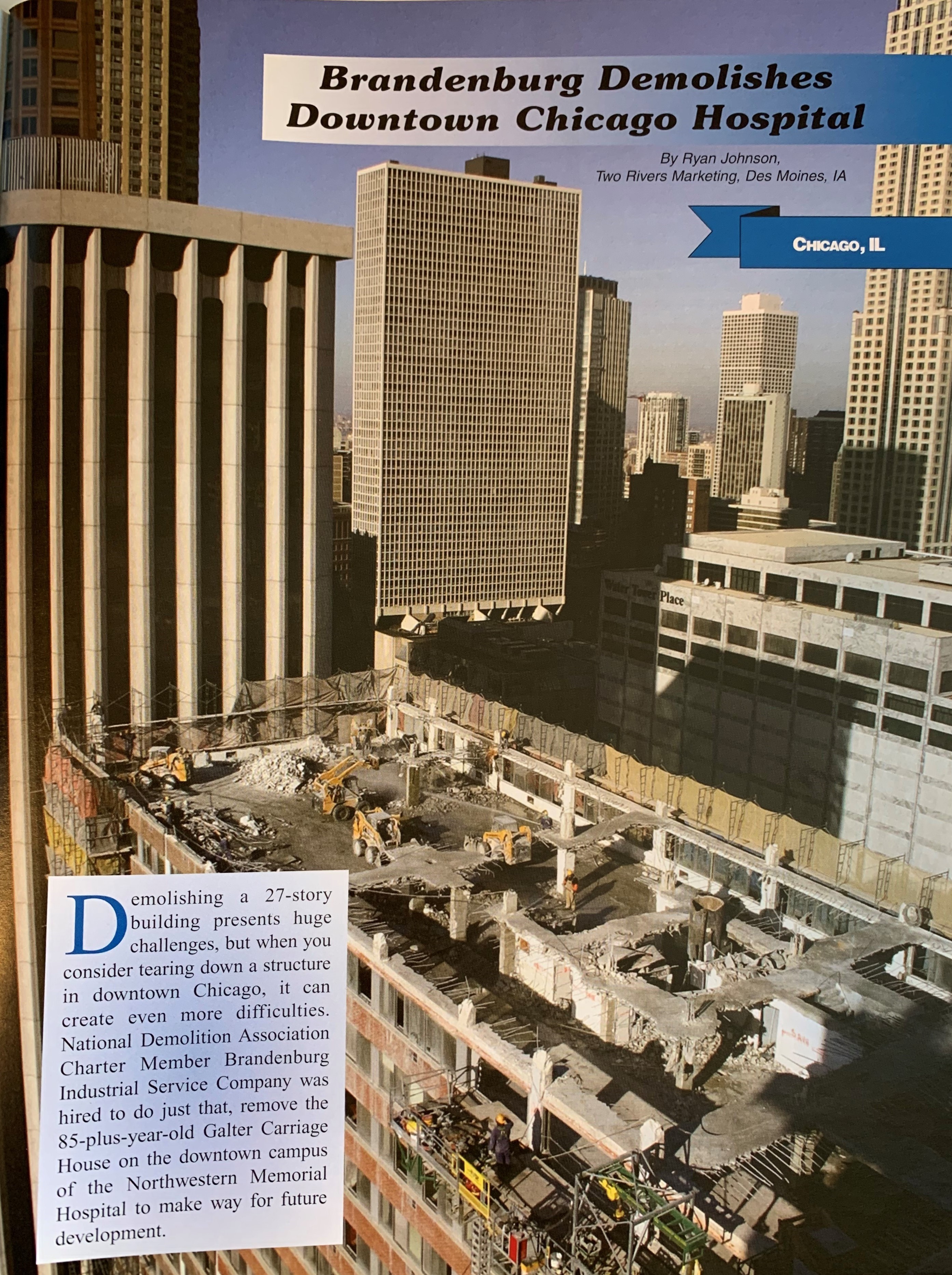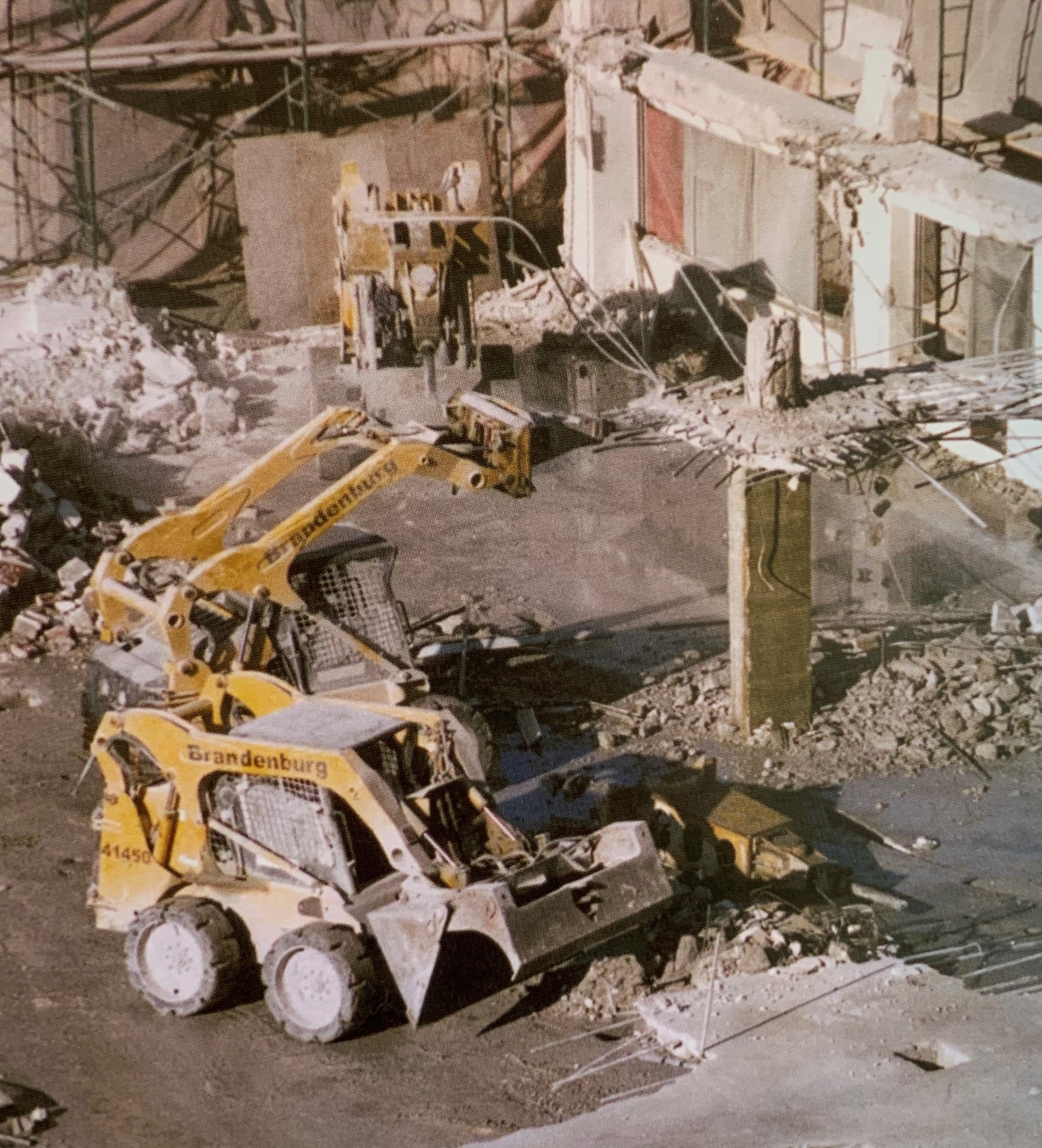Brandenburg Demolishes Downtown Chicago Hospital
June 29, 2022
This article was originally published in the July/August 2006 issue of DEMOLITION magazine.
 Demolishing a 27-story building presents huge challenges, but when you consider tearing down a structure in downtown Chicago, it can create even more difficulties. National Demolition Association Charter Member Brandenburg Industrial Service Company was hired to do just that, remove the 85-plus-year-old Galter Carriage House on the downtown campus of the Northwestern Memorial Hospital to make way for future development.
Demolishing a 27-story building presents huge challenges, but when you consider tearing down a structure in downtown Chicago, it can create even more difficulties. National Demolition Association Charter Member Brandenburg Industrial Service Company was hired to do just that, remove the 85-plus-year-old Galter Carriage House on the downtown campus of the Northwestern Memorial Hospital to make way for future development.
Brandenburg is certainly no stranger to working in Chicago’s congested downtown area, having recently completed the demolition of the famous Chicago Sun-Times building for Donald Trump to make way for his new 92-story Trump International Hotel and Tower.
According to Kelly Sullivan, Media Relations Director at Northwestern Memorial Hospital, the Galter Carriage House was originally built as a five-story parking garage, in 1926, along East Chicago Avenue in downtown Chicago. In 1960, additional floors were added to create a 27-story high-rise building that would eventually be used by Northwestern Memorial Hospital to house employees and patients. Lower levels of the Galter Carriage House were also used for retail and commercial purposes. Eli’s Place for Steak, a popular spot for celebrities to visit on their way through the Windy City, which had occupied space in the building since 1966, closed in the summer of 2005 in preparation for the demolition.
John O’Keefe, marketing manager at Brandenburg, says the $3,500,000 project involved the asbestos abatement and demolition of the Galter Carriage House with more than 430,000 square feet of space spread out across 27 floors. Brandenburg crews started their work in September 2005 with an estimated finish date of June 2006.
“One of the keys (in demolition) is protection, especially in a downtown urban area,” O’Keefe says. “For the Northwestern Memorial Hospital, in the area that is facing the street, we had the area set up with scaffolding so any debris that accidentally fell outside the building wouldn’t hit a pedestrian or traffic. You need to set up all of your protective barrier structures before you begin your demolition.
“There is always something you have to protect on these downtown projects,” O’Keefe explains. “That is what makes them hard. You don’t have a lot of room to work, and it makes it difficult. It is much different from an industrial site where you typically have a large, open area around the building to work with.”
Before any demolition was started on-site, Brandenburg crews had to remove the asbestos that was present in the structure. Crews found the hazardous material in floor tile, insulation surrounding pipes, and in some of the building’s doors.
After the environmental portion of the project was completed, crews made sure the electricity to the building was cut off or isolated, as well as the sewer and water service. Some electrical service was left in the building for lighting to do the demolition work and some water for fire prevention.
“These are isolated because one of the most dangerous things in demolition is cutting utilities that are live; you want to stay away from that,” O’Keefe explains.
With little room to work on-site, the equipment needed to carry out a project of this magnitude must be compact and versatile. Brandenburg utilized a small fleet of Bobcat skid-steer loaders and attachments to assist with the demolition of the Galter Carriage House, according to O’Keefe. He says the company typically uses machines like Bobcat loaders, starting at the top of the structure as operators demolish the floors and eventually work their way down.
But how do these compact loaders access the top of a 27-story downtown building? There are a couple ways to transport these machines and attachments. O’Keefe says one way is to simply lift the machines to the top of the building with a crane.
“We lift them up to the top and drop them off one-by-one,” O’Keefe says. “In some cases, there might be a freight elevator still working, or construction managers may build a freight elevator on the side of the building to carry the machines to the top.”
According to O’Keefe, before the Bobcat loaders are used on any floor, an engineering survey is performed to determine if the floor structures are strong enough to hold the 8,400-pound machine. Once deemed workable, the loaders travel across these floors and use hydraulic breaker attachments to tear apart the concrete, drywall, and studs. O’Keefe says the hydraulic breaker attachments are more precise than many of the other attachments available for their demolition applications.
“You can go around an area, break out the floor between the columns, and drop it,” he explains. “We want to open up the floor completely. The only thing remaining would be the columns supporting the last portion of the structure removed on each floor so that you can support your machines until you get down to the next floor.
“Once the machines are up there, we typically use ramps to drive them from one floor down to the next,” O’Keefe says. “We’ll wreck the building down until we get to the little area we have left. You’re basically going to demolish the building from the top down until you can reach it — down to a few floors — with the rest of your larger equipment, like excavators. Once the building can be reached with excavators, skid-steer loaders are removed from the structure and utilized on the ground to assist with the cleanup and sorting debris.”

During the entire process, the Brandenburg loaders equipped with solid rubber tires loaded and pushed demolition debris with bucket attachments to chutes on the sides of the building or elevator shafts where the material falls to a lower level. Then, skid-steer loaders located at the base of the structure sift through the debris with industrial grapple attachments to sort it, and help wheel loaders carry some of the debris to nearby dumpsters where it is taken to a landfill or recycling center. Most of the sorting is done by the skid-steer loaders and excavators, but in some situations it still requires manual labor.
“Most of our machines are very precise on what they can grab,” O’Keefe says. “Our large excavators, with a shear, can pick up a pop can … the machines have come a long way with hydraulics and rotation. They do a lot of the sorting for us.”
Brandenburg estimators calculated the demolition debris produced during this project included 3,400 tons of garbage, 8,600 tons of brick, 1,600 tons of steel, and 32,000 tons of concrete will be removed from the concrete-reinforced structure. The brick and concrete will be used as fill material or recycled, for uses such as road-base. With little room on-site to process the steel, it was set aside, and eventually 1,600 tons were hauled off to a preparation site and cut to a prepared size for melting in steel mills.
Located behind the demolition site is a new building: the Prentice Women’s Hospital, which is scheduled to open in spring 2007. Brandenburg performed the excavation of this site in preparation for a new 937,000 square foot hospital building. Northwestern Memorial Hospital says that the new women’s hospital will consist of diagnostic treatment space, patient care areas, and medical office spaces.
Plans have yet to be announced for what will be located on the Galter Carriage House site. Officials say it will become a parking lot temporarily but may eventually be used for future hospital expansion.